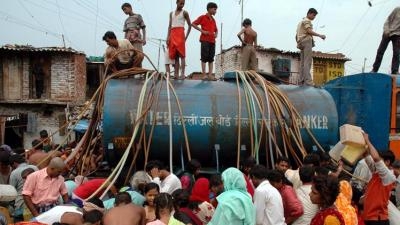Temperatures have soared in India this summer. The scanty monsoon rains have been unable to replenish reservoirs or recharge diminishing groundwater. Much of the country is reeling under acute water shortages. In water-starved cities like Delhi, those who can afford it pay large sums to private suppliers to fill up household tanks.
The poor rise at unearthly hours to store a few bucketfuls from an erratic municipal supply, or push and shove to fill buckets and pans from government tankers that visit their area only occasionally. Fights over water are common.
India’s burgeoning cities, already bursting at the seams, are struggling to provide their residents with basic services. No Indian city receives piped water 24 hours a day, seven days a week. Raw sewage often overflows into open drains, polluting ponds, rivers, and groundwater.
Although cities like Delhi receive with 220 liters of water per person per day – much more than Paris, for instance – some 40-70% of this water is lost due to physical and financial leakages.
Consumers bear the brunt of these inefficiencies. Nor are municipalities any better off. They are only able to recover a mere 30-40% of their operations and maintenance costs, leaving most to survive on government subsidies to meet their O&M costs as well as capital investment.
Massive urbanization
There is a clear need to revamp the system. No time can be lost, as India is in the throes of an unprecedented urbanization, the second in the world after China, with a further 10 million people expected to move into the urban areas each year.
Recognizing this, the Indian government has been implementing an ambitious urban renewal program for the past five years. About 70% of the $12 billion allocated for the program – the Jawaharlal Nehru National Urban Renewal Mission (JNNURM) – has been earmarked for improving water supply and sewers. It is estimated that the sector will need a further $140 billion in capital investment over the next 20 years.
Learning from others’ experience
There is a growing realization that creating infrastructure alone will not solve the problem; the management of urban water supply services will also need to be addressed to arrive at a sustainable solution.
To find a way forward, the World Bank and India’s central Ministry of Urban Development, recently brought out a report, “Improving Urban Water Supply and Sanitation Services – Lessons from Business Plans for Maharashtra, Rajasthan, and Haryana and International Good Practices.” The report, released at a recent workshop in New Delhi, seeks to address the key issues facing the sector in India’s states and cities.
The report highlights the different water supply scenarios prevailing in the country today. It looks at three states that present a similar picture in terms of access to piped water supply but differ considerably when it comes to the quality of service provided. The report finds that while towns in Haryana, for instance, had the highest average quantity of water available per person per day, supply was irregular and varied widely between seasons. Towns in Maharashtra, on the other hand, had less water available but benefited from a more regular supply. Rajasthan, the desert state, had the least availability of water and the least reliable supply, with only 162 out of the state’s 222 towns receiving water every day. The cost recovery scenario presented an even more diverse picture. While the average recovery rate in Maharashtra was 68%, it dropped to 35% in Rajasthan and a mere 11% in Haryana.

